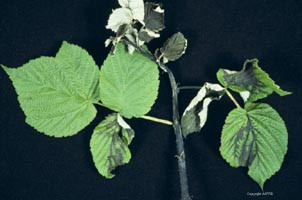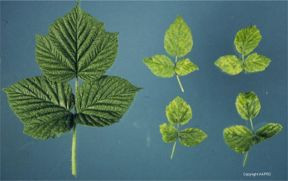Non-urgent government operations are closed December 24 to January 1, reopening January 2. View available services during this period.
Botrytis Fruit Rot
Botrytis cinerea
Symptoms
- as berries ripen, few infected druplets can develop a watery rot and golden or tan colour
- soft, gray fungal spores grow on these watery spots when humidity is high
- mid to late part of the season when problems arise
Conditions favouring disease
- overwinters on canes, dead leaves and mummified berries
- pre-harvest, wet weather during blossom time, disease remains latent
- disease is spread by spores by wind and splashing water (rain and overhead irrigation)
- more mature and over ripe fruit becomes, the greater the risk
- high relative humidity in cooler weather, (16-26oC) encourages the mold growth
- post harvest, high relative humidity in the cooler encourages mold growth
- infected berries leak on to other berries, spreading disease
Control
- avoid dense planting
- increase air circulation, rigorous pruning, efficient weed control, avoid high applications of nitrogen
- harvest regularly and sell as soon as picked
- pick directly into shallow containers for market
- cool fruit as quickly as possible
Cane Botrytis (Gray Mold Wilt)
Botrytis cinerea
Symptoms
- appear mid summer
- pale brown lesions (with no purple cast)
- often have conspicuous band patterns or watermarks, due to the irregular growth patterns of the fungus
- when primocanes turn brown in the fall, the lesions become indistinguishable from healthy tissue
- after several weeks of low temperatures the lesions turn gray or white
- sclerotia form during winter and emerge as shiny black blisters in the spring
- when the surface tissues are scraped away healthy green tissue underneath is exposed
- cane botrytis does weaken the stem
- in spring difficult to tell difference between spur blight and cane botrytis, in fact both can be present on the same cane as both occupy the same ecological niche and do similar things to plant growth
Conditions favouring disease
- wet weather or high humidity
- poor air circulation
- spread mainly by wind but also by splashing water (rain or overhead irrigation)
- disease overwinters on canes
Control
- avoid dense planting
- increase air circulation, rigorous pruning, efficient weed control, avoid high applications of nitrogen
- prune out infected canes
Cane Blight
Leptosphaeria coniothyrium
Symptoms
- dark brown to purplish cankers form at wound on new canes
- as cankers enlarge and extend down the canes, lateral shoots can suddenly wilt and die
- wilting death may also occur on the side shoots of second-year canes
- affected canes are brittle and snap off easily
- fruiting canes often die between flowering and fruiting
- scrape the brown spot on cane with knife, will be brown discoloration under the bark
Conditions favouring disease
- two most important factors for disease; a wound for the disease to enter and water to wash the organism into wound
- wet weather, spores ooze from the fruiting bodies
- spores spread on the wind
- young canes are susceptible
Control
- sunny planting spot
- good air movement and water drainage
- wind break to reduce damage to canes by wind
- disease free material
- minimize mechanical injury to canes
- remove old canes at ground and destroy
- control insect pests
Spur Blight
Didymella applanta
Symptoms
- dark red, purple or chocolate brown spots below the spur, on young bark around buds of new shoots
- canes have silvery grey appearance in the winter
- diseased areas enlarge and girdle the stem, as a result the leaves fall off, especially on the lower parts of stem
- infected bark may dry out and crack by late summer
- yields and winter hardiness are reduced
- fungus survives year to year on the infected canes
Conditions favouring disease
- cool rainy weather
- spores spread by wind and splashing water
- spores present at all times
- disease enters at leaf nodes and stems
Control
- prune out and destroy diseased canes (young and old) after harvest
- avoid dense planting
- control weeds
- use healthy stock
- balanced nitrogen program
- encourage good air circulation in planting
Powdery Mildew
Sphaerotheca macularis
Symptoms
- powdery white growth on leaf underside, growing tip or fruit
- young canes, stunted, distorted, spindly and can die back
- young berries fail to mature to full size, whither and die
Conditions favouring disease
- most prevalent in years when weather is dry and air circulation is poor, (warm and humid weather)
- can affect winter hardiness
Control
- remove diseased material in fall and destroy
- good row spacing and proper pruning
Root Rots
Pythium, Phytophthora, Rhizoctonia and Fusarium
Symptoms
- unthriftiness
- appear to be suffering from lack of moisture or nutrients, but when these are added, there is no response
- leaves are smaller than normal, shorter petioles and become wilted or discoloured
- fruiting canes produce fruit that is stunted and never sizes up
- berries may be seedy
- roots are dark brown to black, with discoloration extending to the crown
- rootlets are sparse or non existent
Control
- well drained soil
- clean stock
- do not follow strawberries, potatoes, tomatoes or raspberries in the rotation
- remove and destroy badly infected plants
Fire Blight
Erwinia amylovora
Symptoms
- primocanes will shepards crook
- can girdle canes
- lesions become water soaked
- carmel coloured bacterial ooze comes out of lesions in beads during humid periods
- diseased plant parts become purplish black
- infected berries do not mature, become brown, dry up, become very hard and remain on pedicel

Fireblight symptoms on raspberry
Conditions favouring disease
- apple strain will attack raspberry, but not vice versa
- bacteria is present from overwintering cankers on diseased plant material
- warm temperatures (18-25oC) and light rain favour infections, prolonged host flowering due to wet cool springs
- flowers, fruit, cane tips that are succulent become infected
- bacteria needs a place to enter the plant, whether flower or mechanical damage
Control
- pruning is the best method of control
- copper sprays act as protectants, not control
- sprays must be directed into open flowers to be effective
- For more detailed information about Fireblight, see Alberta Agriculture's Agdex 636-1.
Bacterial Blight
Pseudomonas syringae
Symptoms
- very similar to fireblight symptoms
- blackening or browning of tissue
- slow in spreading unlike fireblight
- can also be confused with several other disorders like winter injury, cane borer, or some herbicides
Conditions favouring disease
- cool and moist weather
- overwinters on the canes and buds
- bacteria needs a place to enter, whether frost damage or mechanical damage
- bacteria is systemic in the plant, and infection spreads as long as weather is cool and wet, once weather begins to warm up disease subsides until fall
Control
- pruning is the best method of control
- copper sprays act as protectants, not control
- harden plants for winter properly
Virus Diseases
various causes
Symptoms
- poor vigour
- low yields and poor fruit quality
- short stand longevity
- leaf symptoms most evident during cool weather, can range from puckering, curling and crinkling
- berries may be dry seedy and lack flavour

Raspberry Mosaic Virus
Control
- virus free stock
- rogue and destroy virus-infected plants
- control insect pests
Physiological disorders
Winter injury
Symptoms
- top part of cane is killed, below the cane may be weakened and leaf out late or produce weak growth
- fruiting canes produce blossoms but berries fail to develop
- berries dry up before ripening
Conditions favouring disorder
- severe in the chinook belt
- low or fluctuating winter temps or low temps in the fall before the canes are mature
- canes wither after leafing out
- tip dieback is common
- yellowing and death of branches at fruiting time is common
Control
- grow winter hardy material
- watch irrigation during fall hardening off period
- plant cover crops to trap the snow, shelterbelts
- do not fertilize too late in growing season
Crumble Berry
Symptoms
- small number of drupelets and crumbly ripe fruit
- possible causes: nutrient deficiencies, variety traits, disease (including viral) and poor pollination
Control
- keep stand disease free
- provide optimal conditions for growth (irrigation, fertilizer and weed control)
Poor Drainage
Symptoms
- most often occurs in late fall or early spring
- high water levels causes the roots to suffocate
- poor root development, when plants are demanding water to produce fruit the roots can not supply
- weak plants
- root disease sets in
Control
- improve drainage
- avoid planting in low spots
Sunscald
Symptoms
- exposed surfaces on ripening fruit become discoloured then develop grayish-white patches
- fruit is unmarketable
Control
- control diseases and insects which cause defoliation
- fertilize adequately
Drought
Symptoms
- wilted, unthrifty
- fruit set and yield are poor
- affects winter hardiness
Control
- irrigate as required
- mulch to preserve moisture